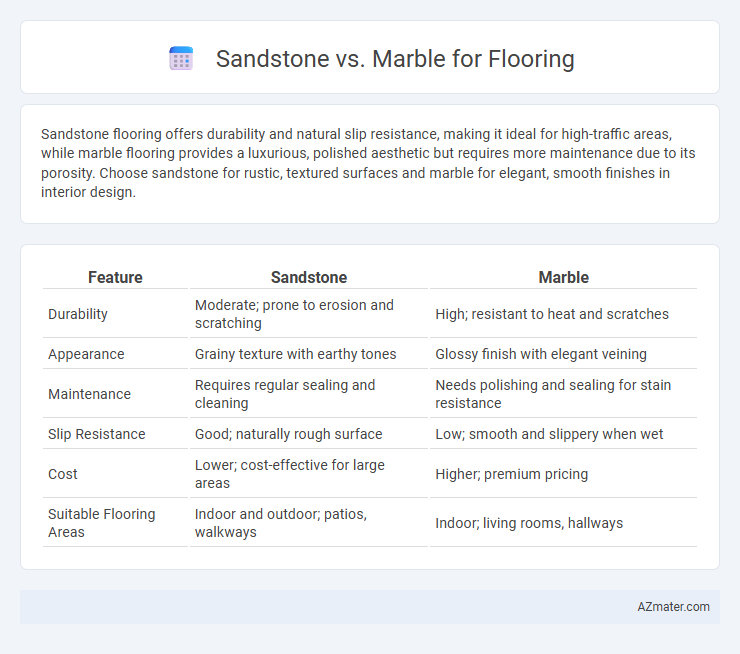Sandstone flooring offers durability and natural slip resistance, making it ideal for high-traffic areas, while marble flooring provides a luxurious, polished aesthetic but requires more maintenance due to its porosity. Choose sandstone for rustic, textured surfaces and marble for elegant, smooth finishes in interior design.
Table of Comparison
| Feature | Sandstone | Marble |
|---|---|---|
| Durability | Moderate; prone to erosion and scratching | High; resistant to heat and scratches |
| Appearance | Grainy texture with earthy tones | Glossy finish with elegant veining |
| Maintenance | Requires regular sealing and cleaning | Needs polishing and sealing for stain resistance |
| Slip Resistance | Good; naturally rough surface | Low; smooth and slippery when wet |
| Cost | Lower; cost-effective for large areas | Higher; premium pricing |
| Suitable Flooring Areas | Indoor and outdoor; patios, walkways | Indoor; living rooms, hallways |
Introduction to Sandstone and Marble Flooring
Sandstone flooring offers a durable and textured surface with natural color variations, making it a popular choice for both indoor and outdoor spaces. Marble flooring is renowned for its elegant appearance and smooth, polished finish, often characterized by unique veining patterns that enhance luxury interiors. Both materials provide distinct aesthetic appeal and performance qualities, with sandstone emphasizing rustic charm and marble delivering timeless sophistication.
Key Differences Between Sandstone and Marble
Sandstone flooring features a naturally textured surface with earthy tones, offering excellent slip resistance and durability for high-traffic areas. Marble flooring exhibits a smooth, polished finish with elegant veining patterns, known for its luxurious appearance but requiring more maintenance due to its porosity and susceptibility to staining. The key differences lie in sandstone's rugged, slip-resistant properties versus marble's refined aesthetic and higher maintenance needs, influencing their suitability for different flooring applications.
Aesthetic Appeal: Sandstone vs Marble
Sandstone flooring offers a warm, earthy aesthetic with natural grain patterns and subtle color variations, creating a rustic and inviting atmosphere. Marble flooring provides a luxurious and elegant appearance with its smooth, polished surface and distinctive veining patterns, often in shades of white, black, or green. Both materials enhance interior spaces, but marble's high-gloss finish gives a more sophisticated and timeless appeal compared to the natural, textured look of sandstone.
Durability and Strength Comparison
Sandstone flooring offers moderate durability with a hardness rating of 6 to 7 on the Mohs scale, making it suitable for low to medium traffic areas but prone to scratching and wear over time. Marble, rated around 3 to 5 on the Mohs scale, is softer but denser, providing a strong, long-lasting surface that resists compression and can withstand heavy foot traffic when properly sealed. For structural strength, marble outperforms sandstone due to its compact crystalline structure, but sandstone's natural slip resistance and weathering qualities make it preferable in certain environments.
Maintenance Requirements for Each Material
Sandstone flooring requires regular sealing to prevent water absorption and staining due to its porous nature, and it benefits from gentle cleaning with pH-neutral detergents to avoid surface damage. Marble flooring demands frequent sealing and polishing to maintain its glossy finish and to resist etching from acidic substances, making it essential to clean spills promptly. Both materials need professional maintenance periodically, but marble tends to require more intensive upkeep to preserve its luxurious appearance.
Cost Analysis: Sandstone vs Marble Flooring
Sandstone flooring typically costs between $5 to $15 per square foot, making it a more affordable option compared to marble, which ranges from $10 to $30 per square foot depending on quality and origin. Installation expenses also vary, with marble requiring specialized labor due to its density and fragility, often increasing total project costs by 20-30%. Long-term maintenance costs favor sandstone as it generally resists staining and cracking better than marble, which demands regular sealing and polishing to preserve its appearance.
Slip Resistance and Safety Factors
Sandstone flooring offers superior slip resistance due to its natural textured surface, making it an excellent choice for areas prone to moisture or heavy foot traffic. In contrast, marble has a smooth, polished finish that can become slippery when wet, increasing the risk of slips and falls. Considering safety factors, sandstone's porous and abrasive nature enhances grip, while marble requires additional treatments or mats to improve traction in high-risk zones.
Environmental Impact and Sustainability
Sandstone flooring demonstrates lower environmental impact due to its natural abundance and easier quarrying processes, resulting in reduced energy consumption and carbon emissions compared to marble. Marble extraction and processing involve intensive mining and high-energy polishing techniques, increasing its carbon footprint and waste generation. Sustainable flooring choices prioritize sandstone for its durability, minimal chemical treatment, and ecological benefits in maintaining soil stability and reducing habitat disruption.
Best Applications for Sandstone and Marble
Sandstone flooring is ideal for outdoor patios, walkways, and areas prone to moisture due to its natural slip resistance and durability. Marble excels in indoor spaces like living rooms, hallways, and bathrooms, where its elegant appearance and smooth finish enhance aesthetic appeal. Both stones require proper sealing, but marble's susceptibility to scratching makes it less suitable for high-traffic or heavily used outdoor environments.
Conclusion: Choosing the Right Flooring for Your Needs
Sandstone offers durability and natural slip resistance, making it ideal for high-traffic areas and outdoor flooring, while marble provides elegant aesthetics and a polished finish suited for formal interiors. Consider factors such as maintenance, budget, and location when selecting between sandstone's rustic charm and marble's luxurious appeal. Opting for the flooring material that aligns with your lifestyle and design goals ensures long-lasting satisfaction and functionality.

Infographic: Sandstone vs Marble for Flooring
 azmater.com
azmater.com